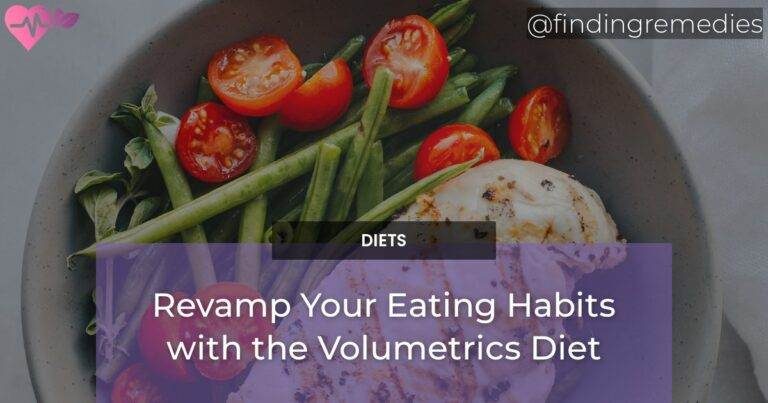The Volumetrics diet is a popular eating plan that focuses on consuming nutrient-dense, low-density foods to promote weight management and overall health. This diet was developed by Barbara Rolls, a nutrition researcher at Penn State University, and emphasizes the importance of food volume and satiety in achieving long-term weight loss success.
Table of Contents
Overview
The Volumetrics diet is a lifestyle modification plan that emphasizes the importance of eating filling, fiber-rich foods that are low in calories. The goal of this eating plan is to help individuals feel full and satisfied with their meals while reducing overall calorie intake. By incorporating more low-density foods into the diet, individuals may experience improved satiety and reduced hunger cravings.
Key Components
Focus on Low-Density Foods
The Volumetrics diet encourages the consumption of low-density foods, which are foods that have a high water content and low calorie count. Examples of low-density foods include fruits, vegetables, broth-based soups, and whole grains. By consuming more of these foods, individuals may be able to reduce overall calorie intake while still feeling full and satisfied after meals.
Emphasis on Water-Rich Foods
water-rich foods are foods that have a high water content, which can help to increase feelings of fullness and satiety. Examples of water-rich foods include fruits, vegetables, and soups. The Volumetrics diet emphasizes the importance of incorporating these foods into the diet to promote weight loss and improved overall health.
Incorporation of Lean Protein
Lean proteins, such as chicken, fish, and tofu, are important components of the Volumetrics diet. These foods can help to promote feelings of fullness and satiety, which may reduce overall calorie intake. Additionally, lean protein sources are lower in calories than fatty meats, which can help to reduce total calorie intake and promote weight loss.
Limitation of High-Density Foods
High-density foods are foods that are high in calorie count and low in volume. Examples of high-density foods include fried foods, sweets, and fatty meats. The Volumetrics diet recommends limiting consumption of these foods in favor of nutrient-dense, low-density options to promote weight loss and improved overall health.
ALSO READ
Health Benefits
Sustainable Weight Loss
The Volumetrics diet has been shown to promote sustainable weight loss over time. By consuming more low-density, nutrient-dense foods, individuals may be able to reduce overall calorie intake without feeling deprived or hungry. This can lead to gradual, sustainable weight loss over time.
Improved Nutrient Intake
The Volumetrics diet emphasizes the consumption of nutrient-dense, low-density foods, which can help to improve overall nutrient intake. By incorporating more fruits, vegetables, and whole grains into the diet, individuals may be able to increase their intake of important vitamins, minerals, and fiber.
Reduced Risk of Chronic Diseases
Research has shown that the Volumetrics diet may help to reduce the risk of chronic diseases, such as heart disease, diabetes, and obesity. By promoting healthy eating habits and lifestyle modifications, the Volumetrics diet may help to improve overall health and reduce the risk of chronic disease development.
Scientific Evidence
Studies on Weight Loss
Several studies have been conducted on the effectiveness of the Volumetrics diet for weight loss. A review of 12 studies found that the Volumetrics diet was associated with significant weight loss and improved satiety compared to other popular diets.
Research on Nutrient Intake
Research has also shown that the Volumetrics diet can help to improve overall nutrient intake. A study published in the Journal of Nutrition found that individuals following the Volumetrics diet had higher intakes of fiber, potassium, vitamin C, and vitamin E compared to those following a typical American diet.
Observations on Chronic Disease Prevention
Observational studies have also found that the Volumetrics diet may be associated with a reduced risk of chronic diseases. A study published in the Journal of the American Dietetic Association found that individuals following the Volumetrics diet had a lower risk of developing heart disease compared to those following a typical American diet.
ALSO READ
Tips for Success
Practice Portion Control
- Use smaller plates and bowls to reduce portion sizes
- Measure foods to ensure proper serving sizes
- Avoid eating directly from packages to reduce mindless snacking
Plan Meals Ahead of Time
- Create a meal plan for the week to ensure healthy food choices
- Prepare meals in advance to save time during the week
- Keep healthy snacks readily available to avoid unhealthy choices
Stay Hydrated
- Drink plenty of water throughout the day to stay hydrated
- Choose water-rich foods to increase hydration
- Avoid sugary drinks and high-calorie beverages
Risks and Precautions
Potential for Inadequate Nutrient Intake
The Volumetrics diet emphasizes the consumption of low-density, nutrient-dense foods, which can help to improve overall nutrient intake. However, it is important to ensure that adequate amounts of essential vitamins and minerals are being consumed to avoid nutrient deficiencies.
Difficulty Sticking to The Diet
Like any diet or lifestyle modification plan, the Volumetrics diet may be difficult to stick to for some individuals. It is important to find healthy habits and dietary patterns that work for you and your lifestyle to ensure long-term success.
Conclusion
The Volumetrics diet is a popular eating plan that emphasizes the importance of consuming low-density, nutrient-dense foods to promote weight loss and improved overall health. By focusing on food volume and satiety, individuals may be able to reduce overall calorie intake without feeling deprived or hungry. With the incorporation of healthy habits and lifestyle modifications, the Volumetrics diet may lead to sustainable weight loss and improved overall health.
RELATED ARTICLES:

